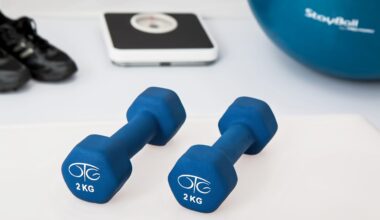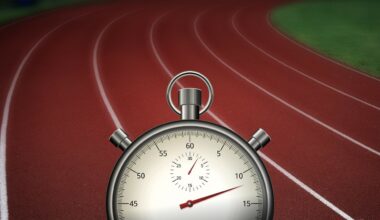Using Biomechanics to Optimize Prosthetic Limb Energy Storage and Return Mechanisms
In the realm of prosthetics and orthotics biomechanics, optimizing energy storage and return mechanisms is paramount. Modern prosthetic limbs must mimic the natural function of biological limbs to enhance user experience. This involves intricate engineering that focuses on materials, design, and mechanics to achieve maximum energy efficiency. The complexity of human gait necessitates that prosthetics not only support weight but also assist in energy return during movements such as walking or running. This application of biomechanics ensures that energy expended by the user is effectively stored and later returned, reducing fatigue and allowing the wearer to engage in various physical activities. Researchers harness principles of biomechanics to innovate designs and materials. Advanced engineering techniques can lead to the development of artificial muscles and responsive mechanisms that adapt to user dynamics. These innovations enhance flexibility and increase the adaptive qualities of prosthetic limbs, making them more intuitive and easier to use. By focusing on both energy storage and return, developers can improve user mobility and comfort, thus improving the quality of life for those with limb loss.
This understanding of energy dynamics significantly transforms the manufacturing and design processes of prosthetics. It opens up possibilities for custom-built devices tailored to individual user needs. Employing biomechanical insights can lead to specific adaptations based on personal activity levels and conditions. Personalized prosthetics account for variations such as body weight, lifestyle, and specific activities, enabling more effective energy transfer. These adaptations enhance the overall performance of the prosthetic limb by ensuring that energy storage devices are aligned with the wearer’s unique biomechanics. The goal is to create a seamless experience where the transitions between storing and releasing energy are nearly imperceptible to the user. Furthermore, advancements in material science contribute substantially to designing lightweight yet strong prosthetics. Innovative materials, including carbon fiber and advanced polymers, allow for energy-efficient mechanisms without excess weight. This results in limbs that are not only functional but also reflective of the aesthetic preferences of users. The integration of biomechanical principles into the design phase fosters a holistic approach, emphasizing user comfort and performance as essential components in prosthetic developments.
The Role of Robotics and Sensor Technology
Robotic technology and sensor integration play critical roles in modern prosthetic developments. By incorporating sensors into prosthetic limbs, developers can gather real-time data about user movements and gait patterns. This data is crucial for optimizing the design and functionality of energy storage mechanisms. For instance, sensors can detect the speed and angle of movement, allowing mechanisms to adjust in response to various activities like running or climbing stairs. Such adaptability requires an intricate balance between biomechanics and robotics, leading to prosthetics that react dynamically to the user’s intentions. Enhanced feedback loops provide not just the user with improved control but also guide future designs. The marriage of dynamic energy storage systems and responsive robotics can drive future innovations in the field. These advancements could result in systems that not only store energy more efficiently but also predict user needs based on their activity patterns. Continuous learning algorithms can improve motion execution over time, contributing to a more natural user experience.
Prosthetics incorporating robotic elements provide enhanced capabilities, allowing users greater independence and mobility. Additionally, the focus on energy efficiency helps mitigate potential injury risks associated with traditional prosthetic devices. Higher energy return prosthetics can diminish stress on residual limbs, promoting longer-term health benefits. The inherent benefits of such innovations cater to athletes and active individuals who prioritize energy return for optimal performance in their pursuits. As biomechanics and robotics converge, the development of smart prosthetics becomes attainable. These high-tech devices adapt and respond more proficiently to user needs, demonstrating an unprecedented level of personalization. For instance, some advanced prosthetics can automatically switch modes between different activities, adjusting the energy storage levels based on user intent and environmental changes. These interactions help recreate the fluidity found in natural limb movement, ultimately enhancing the quality of life for users. Moreover, fostering collaboration between engineers, clinicians, and biomechanists is key to understanding the interplay of biomechanics in prosthetic design.
Impact of Research and Development
Research in biomechanics continues to play a transformative role in shaping prosthetic technology. Investigations into natural limb movement mechanics inform the design of prosthetic limbs that replicate these movements more effectively. With continuous advancements in biomechanical research, the potential for energy-efficient prosthetic devices grows exponentially. As scientists uncover new insights into how energy transfer occurs in biological limbs, they can apply similar principles to artificial limbs. Research funding drives innovation, leading to breakthroughs that enhance the integration of technology with user needs, paving the way for higher quality prosthetics. Collaborative research efforts boost knowledge sharing among institutions, contributing to the overall progress in this field. Additionally, user feedback on prototypes assists developers in making informed adjustments before mass production. Engaging the user community during the testing phases conditions the development process to better suit user requirements, improving the satisfaction regarding energy return functionalities.
Effective research also focuses on long-term outcomes associated with optimizing energy storage in prosthetics. A comprehensive understanding of biomechanics can directly translate to rehabilitative strategies that promote user independence. Through clinical trials and evidence-based studies, researchers can analyze the performance of various designs, comparing different materials and structures for optimal results. This ongoing cycle of testing and refining enables the development of prosthetics that are not only effective but also sustainable for longer life spans. Through embracing a multidimensional approach, the understanding of biomechanics can facilitate progressive advancements in prosthetic technologies, contributing to significant health and psychological benefits for users. Ultimately, the impact of research extends beyond technology; it reshapes the experiences of individuals adjusting to life with prosthetics, emphasizing their empowerment, dignity, and improved mobility.
Future Prospects in Biomechanics and Prosthetics
Looking towards the future, the integration of biomechanics and advancements in technology promises a revolution in how prosthetics are designed and function. Innovations in AI and machine learning are poised to redefine user interaction with prosthetic limbs. As algorithms become more sophisticated, they can help analyze user behavior, leading to further personalization and efficiency in energy storage and return systems. Future prosthetics may become even more adaptive, learning from a user’s daily movements and refining their mechanisms for enhanced performance. Moreover, the role of telehealth in prosthetic consultations is evolving. Virtual interactions allow for real-time monitoring and adjustments, making it easier to customize energy return functionalities as user needs change. The combination of smart technologies with a deep understanding of biomechanics presents endless possibilities for improved prosthetic designs. New approaches might focus on reducing production costs while enhancing the performance quality of prosthetics, ensuring wider availability and accessibility. Researchers are dedicating efforts to ensure that advancements can reach various populations worldwide, amplifying the benefits of this transformative technology.
In summary, the collaboration between biomechanics, materials science, and advanced technology is central to optimizing prosthetic limb energy storage and return mechanisms. As we explore these connections further, it becomes clear that each advancement contributes significantly to enhancing the lives of individuals with limb loss. The focus on user-adaptive designs aligns with broader trends prioritizing personalization in medical devices. The future holds tremendous potential for developing prosthetics that adapt seamlessly to user needs, ensuring maximal performance across various activities. With ongoing developments in AI, robotics, and material science, we can expect to see prosthetics evolve into even more sophisticated assistive devices. Biomechanics continues to serve as a guiding principle as we navigate these advancements, ensuring that improvements prioritize user comfort and efficacy. Through thoughtful integration of research findings, the field is set to transform how individuals interact with prosthetics, leading to a future where energy return and storage systems are optimized for various lifestyles. As technology progresses, it represents not just a collection of advancements but a revolution in quality of life for those relying on prosthetic limbs.


